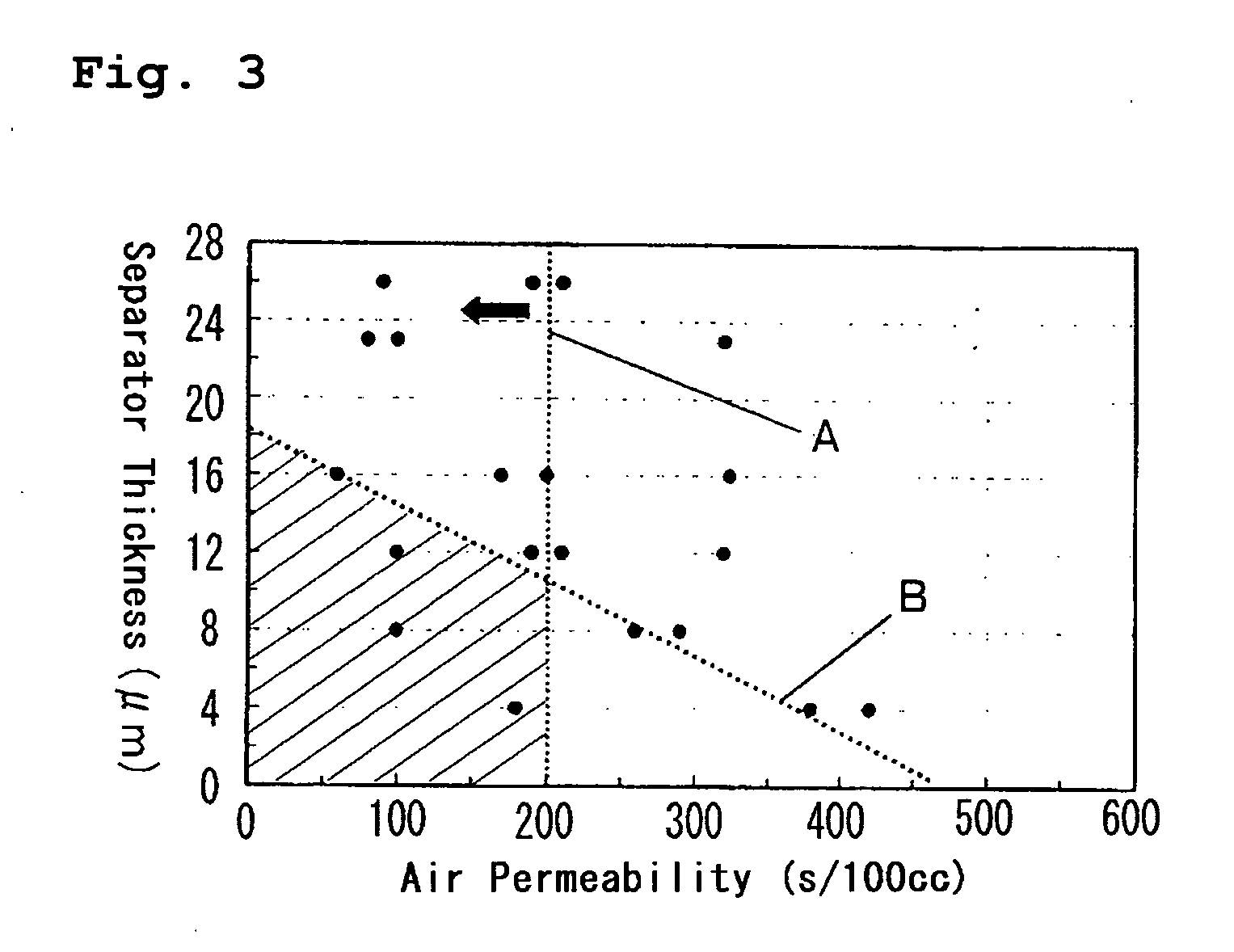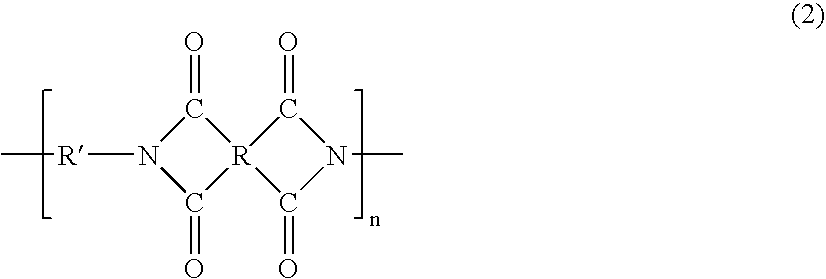Separator for non-aqueous electrolyte battery and non-aqueous electrolyte battery
a technology of electrolyte battery and separator, which is applied in the field of batteries, can solve the problems of degrading battery performance, increasing the demand for higher capacity of battery used as device power sources, and increasing the risk of electrolysis, and achieves good cycle performance, small heat shrinkage, and good heat resistance.
- Summary
- Abstract
- Description
- Claims
- Application Information
AI Technical Summary
Benefits of technology
Problems solved by technology
Method used
Image
Examples
reference experiment 1
[0037] Using polyethylene separators having various air permeabilities, a relationship between air permeability of separator and cycle life degradation was studied. Lithium secondary batteries were constructed using polyethylene separators having various air permeabilities as set forth in Table 1, and their cycle performance was evaluated by a cycle test. Each of the lithium secondary batteries was prepared in the following manner.
[0038] Preparation of Positive Electrode
[0039] Lithium-cobalt composite oxide (lithium cobalt oxide), a carbon conductive agent (SP300), and acetylene black were mixed at a weight ratio of 92:3:2, and 200 g of the mixture was charged into a mixer (mechanofusion system AM-15F made by Hosokawa Micron Corp.), which was operated at 1500 rpm for 10 minutes to mix it under compression, impact, and shearing actions, whereby a positive electrode mixture was prepared. Next, the positive electrode mixture was mixed with a fluoropolymer-based binder agent (PVDF) in...
reference experiment 2
[0054] Lithium secondary batteries were fabricated in the same manner as in Reference Experiment 1, using the polyethylene separators having the air permeabilities set forth in Table 2. With the lithium secondary batteries fabricated, the capacity degradation rates per one cycle at the 50th cycle and at the 100th cycle (the rate of decrease in discharge capacity with respect to initial discharge capacity) were obtained. The results are shown in Table 2 and FIG. 2.
TABLE 2Thickness (μm)232716178Air permeability80101190220280(sec / 100 mL)Capacity degradation0.1020.1040.130.150.19ratio per one cycle atthe 50th cycle(% / cycle)Capacity degradation0.0840.0850.1070.1380.15ratio per one cycle atthe 100th cycle(% / cycle)Thickness (μm)2316201226Air permeability320324405500570(sec / 100 mL)Capacity degradation0.2160.2320.2620.330.36ratio per one cycle atthe 50th cycle(% / cycle)Capacity degradation0.1640.1650.1750.210.212ratio per one cycle atthe 100th cycle(% / cycle)
[0055] Table 2 and FIG. 2 clearly...
reference experiment 3
[0056] The heat shrinkage characteristics of the polyethylene separators having film thicknesses and air permeabilities shown in Table 3 were evaluated in the following manner.
[0057] Measurement of Heat Shrinkage of Separator
[0058] A separator (5 cm×2 cm) was placed between slide glasses and, with both ends of the slide glasses fixed with clips, was retained at a predetermined temperature for 10 minutes; thereafter, percentage of shrinkage was measured.
[0059] The shrinkages of the separators at 120° C. are shown in Table 3.
TABLE 3Film thickness (μm)44488812Air permeability180380420100260290100(sec / 100 mL)Shrinkage at32.620.019.629.419.918.424.6120° C. (%)Film thickness (μm)12121216161616Air permeability19021032060170200324(sec / 100 mL)Shrinkage at21.319.416.219.816.416.214.9120° C. (%)Film thickness (μm)232323262626Air permeability8010032090190210(sec / 100 mL)Shrinkage at16.116.014.815.413.813.8120° C. (%)
[0060] The film thicknesses and air permeabilities of the separators shown ...
PUM
| Property | Measurement | Unit |
|---|---|---|
| Temperature | aaaaa | aaaaa |
| Length | aaaaa | aaaaa |
| Length | aaaaa | aaaaa |
Abstract
Description
Claims
Application Information
 Login to View More
Login to View More - R&D
- Intellectual Property
- Life Sciences
- Materials
- Tech Scout
- Unparalleled Data Quality
- Higher Quality Content
- 60% Fewer Hallucinations
Browse by: Latest US Patents, China's latest patents, Technical Efficacy Thesaurus, Application Domain, Technology Topic, Popular Technical Reports.
© 2025 PatSnap. All rights reserved.Legal|Privacy policy|Modern Slavery Act Transparency Statement|Sitemap|About US| Contact US: help@patsnap.com



